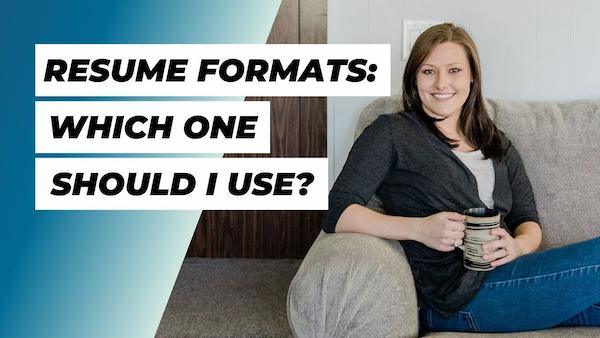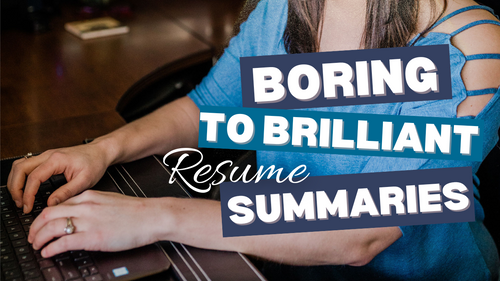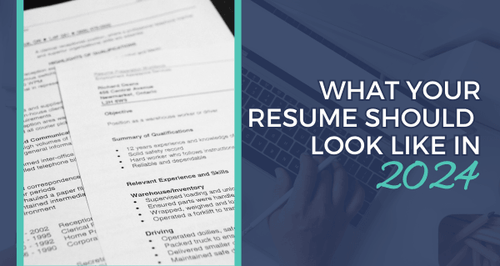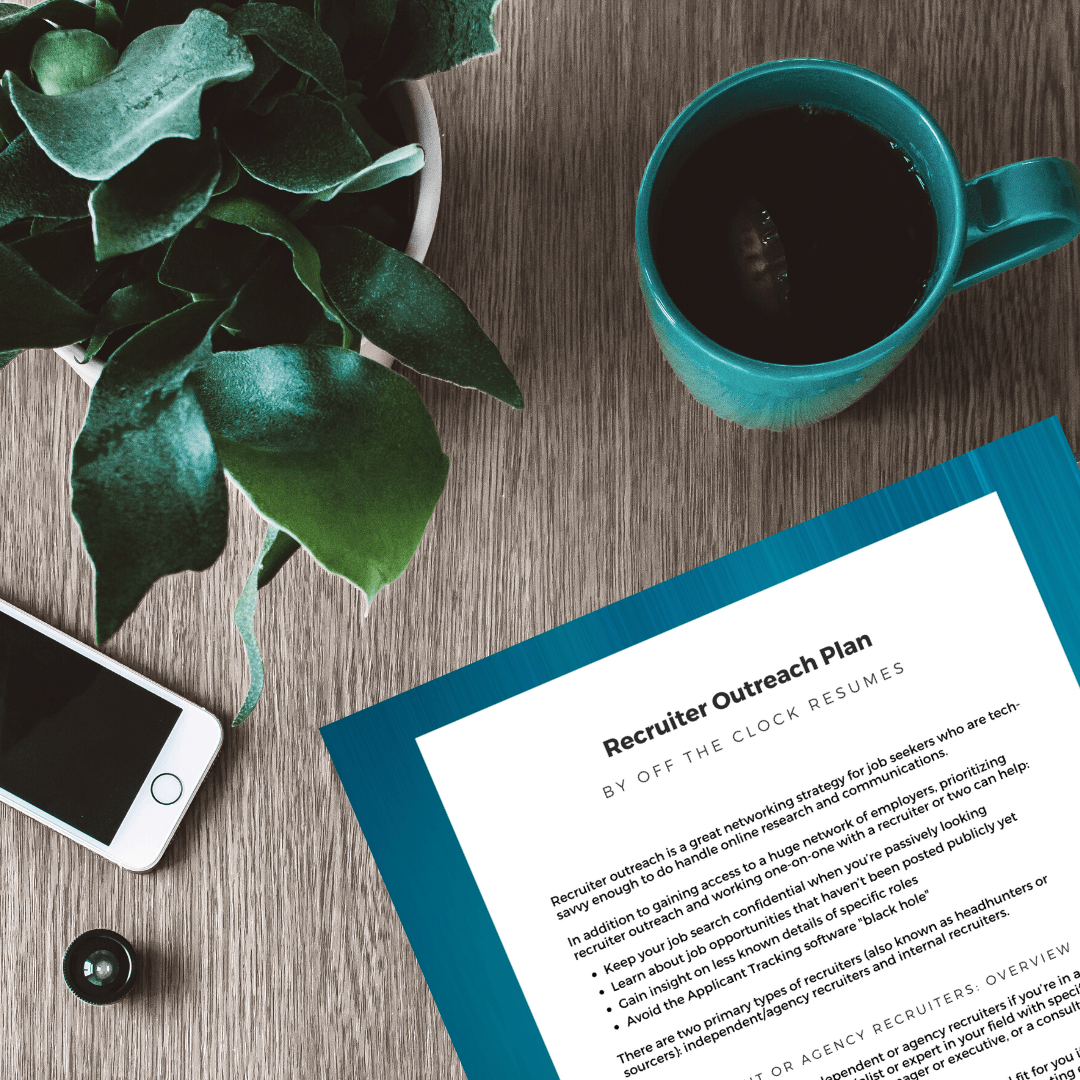
Which Resume Format Should I Use?
There are several different ways to format your background information on a resume. But depending on your career goals and job search strategy, most of the resume formats you've heard about won't be effective.
So, which resume format should you use?
Today, I'm breaking down what each of the 4 most popular resume formats looks like and who it's best for.
This blog contains affiliate links, meaning I may receive a small commission (at no cost to you) if you subscribe or buy something through the links I share. I only share links to products or services that I use myself or absolutely love!
Outdated Resume Formats
Let's start with functional and reverse chronological resume formats. I won't spend too much time describing these formats because they're outdated and rarely effective in today's job market, but it's important that you know how to spot and avoid them when researching resume designs and best practices.
Functional resumes focus primarily on describing skills and only briefly list work history. This resume format was commonly recommended for recent college graduates, career changers, or those returning to work after a significant absence.
The idea behind using a functional resume format was to showcase transferable skills and downplay a lack of relevant or recent experience. Unfortunately, these resumes are instant red flags to recruiters. Recruiters have seen enough of these resumes to know they're used by applicants trying to hide something.
Reverse chronological resumes start with a detailed Experience section with a short list of skills at the end. The work history timeline is organized starting with your most recent job working your way back through previous employers. This was the resume format preferred by recruiters for the longest time because they were more concerned about the experience you had than the skills you claimed to have.
Then the job market became more competitive. Recruiters need help determining what differentiates candidates from others with similar experience. They also need a way to better evaluate candidates with a ton of potential but an unconventional work history.
Chrono-functional / Hybrid Resumes
This brings us to the chrono-functional or hybrid resume format. This is the most flexible format for non-government job seekers as well as the most effective and preferred by recruiters and hiring decision-makers. This resume format combines the best aspects of the outdated formats we just covered.
A chrono-functional or hybrid resume format starts with personal branding elements that are similar to a functional resume approach—specifically, a Summary and easy-to-skim Skills section that introduces your top qualifications and job-related skills or competencies—and transitions into a reverse chronological format for Experience, Education, and additional sections.
To keep your Experience easy to skim and a snapshot of your background rather than a biography, you can alternate between short paragraph job summaries and bullet lists to showcase accomplishments across 1-2 pages.
Job seekers who are changing careers or returning to work after an absence can use this format to highlight selected achievements from transferable skills without creating red flags about your work history or more relevant early career experiences that tend to get buried on a 2nd page.
Recruiters and hiring-decision makers also prefer this resume format because, when done well, it can be easier to skim for the details they are most interested in. It gives applicants a great opportunity to market themselves as the best fit for the job with both their skills and experience working in tandem.
Struggling to get through Applicant Tracking Software? These templates are designed to get through ATS and stand out in all the right ways when in front of hiring decision-makers
Federal or State Government Resumes
If you're creating a resume for federal or state government job opportunities, HR Specialists at these agencies expect a 3 to 5-page detailed resume to adequately assess your level of experience with the Specialized Experience, Knowledge, Skills, Abilities, and Competencies required for the role they're looking to fill.
It must be detailed but still as easy for a human reader to review as possible.
This resume format closely emulates the outdated reverse chronological format we covered earlier. You'll want to start with whatever is minimally required first, whether that's a Certification or your Experience. Your Experience section is then best organized in paragraphs by keywords that align with the required KSAs (or Knowledge, Skills, and Abilities) using bullets to draw attention to accomplishments.
As a Certified Resume Writer, my job is to create a resume that presents you as the best fit for the job that you want by aligning your career story with what recruiters and hiring decision-makers want to see—which is, ultimately, that you understand and can meet the goals of the role you’re pursuing as well as what value you bring to a team based on past performance.
If your resume isn’t conveying this information quickly, clearly, and effectively, I’d love to help!
You can sign up for my free 5-day Resume Rescue Challenge and discover the updates you can make to your resume today to start landing more interviews.
Related Articles
-

26 Interview and Offer-winning Resume Tips for 2026 and Beyond
Upgrade your resume for 2026 with tips that work from design to keywords and strategies that get interviews. Discover what to fix now and stand out fast!
-

The Perfect Resume Length: One Page, Two Pages, or More?
Confused about the ideal resume length? Discover when to use 1, 2, or even 3+ pages plus get tips to highlight your value and land more interviews.
-

The Harsh Truths About Executive Resumes: What Not to Do
Avoid the most common executive resume mistakes that cost you interviews. Discover actionable resume tips to stand out and land C-level roles.
-

Resume Skills That Get You Hired: What To Include (And What To Skip!)
Discover the top resume skills employers want to see on your resume in 2025. Read or watch to learn how to showcase them to stand out and land more interviews.
-

How To Transform Your Resume Summary From Boring To Brilliant
Transform your resume summary from generic to job-winning! Learn how to write a standout branding statement that grabs attention and lands interviews.
-

The Best Resume Tips for Recent Law School Graduates
Guest contributor Luke Bell shares practical resume tips to help recent law school graduates make a lasting impression on potential employers.
-

What Employers Look For In A Resume Skills Section
Learn which key components of an effective Skills section can indicate to resume screening software and the recruiters behind it which skills are your most recent, relevant, functional job-related skills.
-

What Your Resume Should Look Like In 2024
This comprehensive resume guide shares what the most common resume sections are and what your resume should look like in 2024.
-

Is Jobscan Worth It? Jobscan Review (2024 Update)
Have you heard of Jobscan? Learn more about this keyword analysis tool for job seekers, what it costs, and what Certified Resume Writers both love and hate about it in this in-depth product review.
-

How To Showcase Transferable Skills And Your Value For A Career Transition
Recognizing the significance of transferable skills is key to successfully showcasing one's potential in the face of change.
-

How To Showcase Achievements In Your Cover Letter
Learn how to turn your accomplishments into a compelling personal narrative that showcases the results an employer can expect from you.
-

Why You Should Avoid Resume Builders
Online resume builders are an enticing resume resource, but as a Certified Resume Writer who has tried them out, I recommend avoiding them.
-

ChatGPT Review: Resume Writing Edition
How useful is ChatGPT in crafting a resume that lands interviews and job offers? This review by a Certified Resume Writer isn’t what you’d expect.
















